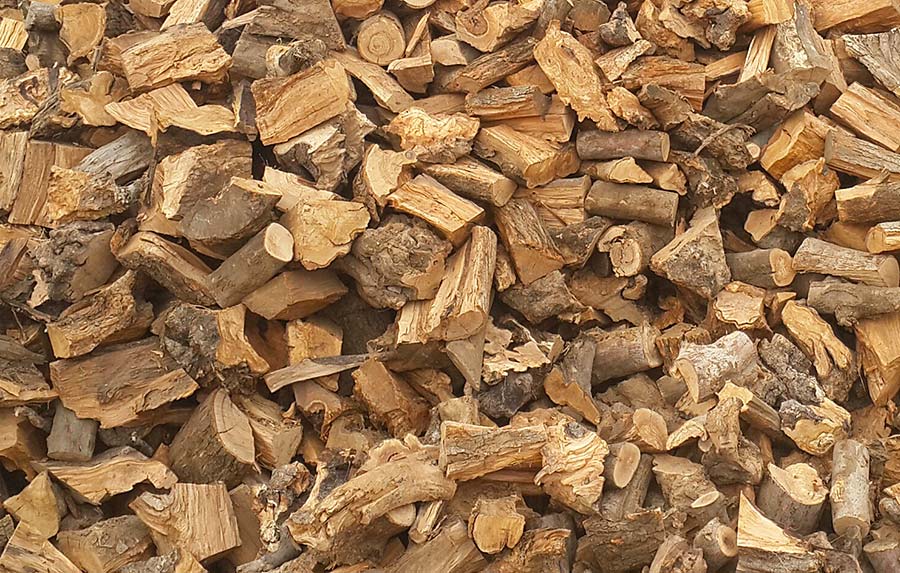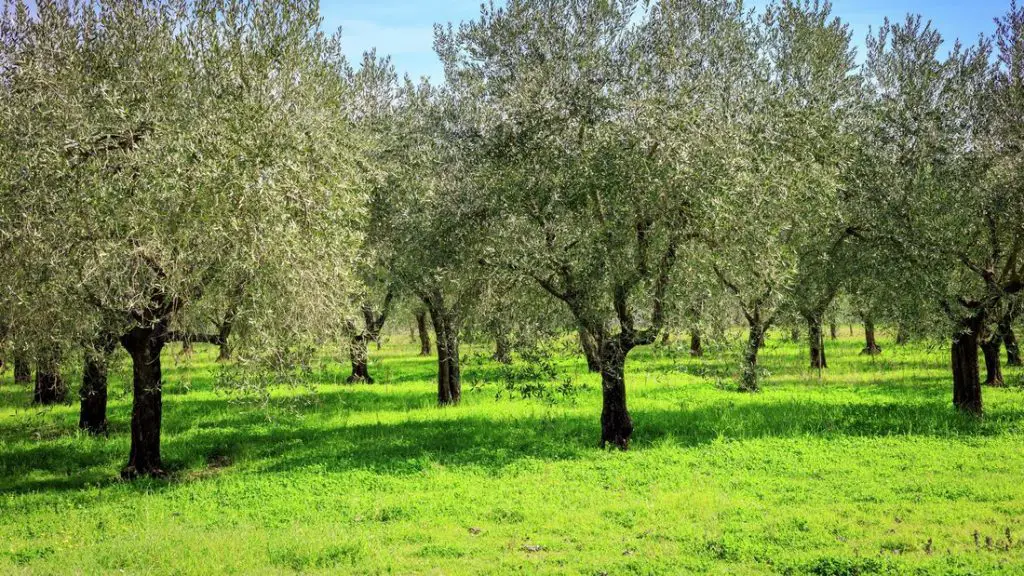Olive wood is excellent firewood due to its high heat production and sweet smell, but its low availability makes it expensive and generates a lot of smoke.
Olive wood has many great things going for it as firewood. With its relatively high BTU rating, olive wood burns hot. It also has a very sweet smell, making it an ideal choice for use in outdoor fire pits. However, its relative scarcity in the United States and its cost make it less-than-perfect for your sole firewood source.
Table of Contents
Summary
- Heat Production: 27 million BTU/cord
- Weight: 6,400 lb/cord green
- Seasoning Time: 12-24 months
- Splitting Difficulty: High
- Sap Content: Medium
- Smoke: High
- Smell: Sweet and pleasant
Olive tends to be a very dense wood, which makes it excellent as firewood. It burns long and hot, as seen from its high BTU rating (which is just behind that of oak) and its weight. Olive wood has a lot of oil in it, which leads to its long seasoning time. It’s also sometimes used to smoke meat.
The biggest stumbling block to using olive wood for firewood is its price and low tree-to-firewood ratio. Since olive trees don’t grow very large, you’ll have to cut down several of them to get the wood you need.

Heat Production
Olive wood burns at a pretty high temperature, clocking in at 27 million BTU per cord. Oak, a popular hardwood for firewood, burns at 28 million BTU per cord, so olive wood isn’t far behind in heat production. Due to the high oil content in olive wood, it’s recommended to keep your fires smaller to start until you get a feel for how it burns in your stove or firepit.
Smoke Generation
Olive wood doesn’t have a high sap content like other hardwoods, so the smoke won’t be as bad. However, the high level of oils in olive wood means that it will produce more smoke than oak, for example. Olive wood is used for smoking meat, so it will generate a decent amount of smoke. Any smoke generated has a pleasant, sweet smell, emblematic of olive wood.
You shouldn’t burn olive firewood indoors unless you have sufficient ventilation to prevent smoke from filling your home.
Seasoning Time
Olive wood takes a bit longer to season than other wood, due primarily to its high oil content. While you should always season firewood to below 20% moisture, olive wood will take at least a year before it’s ready to burn. Remember that burning green wood creates a ton of extra smoke, leading to more creosote buildup in your chimney and stove (if that’s where most of your burning occurs).
A moisture meter is a must-have tool if you’re seasoning a lot of firewood. They’re relatively inexpensive, but they make determining the moisture content of firewood a breeze. Do some research and set a budget before buying a moisture meter.
I personally recommend this General Tools Moisture Meter. It allows you to accurately gauge how wet your firewood is and whether it is sufficiently seasoned. Over time you can also see how quickly the moisture is dropping and how much longer you need to keep your firewood dropping until it is seasoned and ready to burn.
Press the sharp pins into the wood and you will quickly see the readout show the moisture ranging from 5% to 50%. It also has a Low/Mid/High indication depending on whether the wood is dry enough, so you don’t need to remember the actual values.

Burning Smell
If you ask anyone how olive wood smells as it burns, the universal response seems to be that it has a very pleasant, sweet aroma. This is likely due to the high oil content in olive wood. The greener olive wood is when it burns, the more pungent the sweet aroma is likely to be. Even when properly seasoned, olive wood still has a very pleasant, sweet smell.
Creosote Buildup
Creosote is a black ash that can build up in your chimney or wood stove. It’s mostly unburnt wood particles, often from greener softwoods like pine, used for kindling. Creosote is combustible, which means that if too much of it builds up in your chimney, there’s a chance it can catch fire. Burning woods that put off very little creosote is a good safety move.
Olive wood generates less creosote than other woods because it has a low sap content. It’s generally comparable to oak in that regard. The creosote buildup is also lower with olive wood since it burns so hot, and for so long. Generally, wood that doesn’t burn as hot is more prone to creating creosote.
Splitting Difficulty
Olive wood is relatively easy to split. It’s a hardwood, but the trunks of olive trees rarely grow very large. Splitting olive wood is very similar to splitting oak. Since olive wood trees don’t grow very large, you will need to process multiple trees to get a decent yield of firewood.
Different Types/Species
Olive wood is native to Europe and Eastern Africa. It’s most commonly found in the Mediterranean region of Europe. Olive wood comes from the olive trees used to make olive oil and other olive-based products, and this type of wood is not the same as the relatively popular Russian olivewood.
Olive trees don’t grow very large. Most rarely get above 25 feet high, with a trunk diameter around 2 to 4 feet. And, since olives are so economically important, mature olive trees that produce fruit are rarely cut down. Most olive wood on the market comes from trimmings off old trees, some of which can be over 1,000 years old. This is why the cost of olive wood is so high.
Olive wood is also used widely for cooking. It’s a popular wood for cooking pizzas or meats on a smoker or over an open flame.

Comparison to Other Woods
Let’s look at how olive wood compares to the ever-popular oak and some of the other exotic wood species on the market.
Olive wood is great firewood that produces a clean, bright flame with a wonderful aroma. However, its high cost and low availability mean that it’s tough to get your hands on it.
| Firewood | Million BTU/Cord (source) | Ease of Splitting | Coals | Overall Quality |
| Osage orange | 32 | Easy | Excellent | Excellent |
| Olive wood | 27 | Easy | Excellent | Excellent |
| Maple | 25 | Easy | Excellent | Excellent |
| Bur oak | 26 | Easy | Good | Excellent |
Again, olive wood isn’t an easy wood to find. However, as you can see, it’s right up there with Osage orange and oak as wonderful firewood. Most people, however, choose to use it for cooking and stick with other woods as a firewood source.
Frequently Asked Questions
Can you burn olive wood in a firepit outdoors?
Yes, olive wood is a great wood to use in an outdoor firepit. It creates excellent coals for cooking with, produces little smoke, and has a pleasant, sweet aroma when burned.
Is it safe to burn in a fireplace indoors?
Yes, unlike some other exotic hardwoods that burn incredibly hot, you don’t run as much of a risk of buckling or warping a stove or fireplace when using olive wood. Olive firewood does produce more smoke than oak, so ensure you have sufficient ventilation before burning it indoors.
How much does it cost to buy?
Olive wood is expensive and can cost over $600 per cord. It’s not readily available outside of its native range, and olive trees are rarely felled for firewood use due to the economic importance of olives worldwide.
Conclusion
Overall, olive wood is a great firewood choice. It burns hot, for a long time, and produces little smoke or creosote. It has an aromatic, sweet smell and versatile enough to use for cooking, too. However, due to its limited availability on the firewood market, it’s hard enough to find. When you do find it, olive wood is usually cost-prohibitive. It’s more often used in cooking than for firewood.
